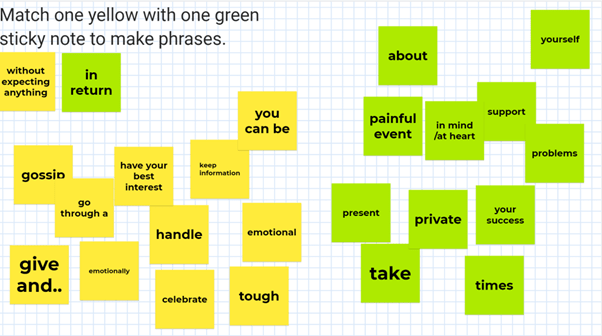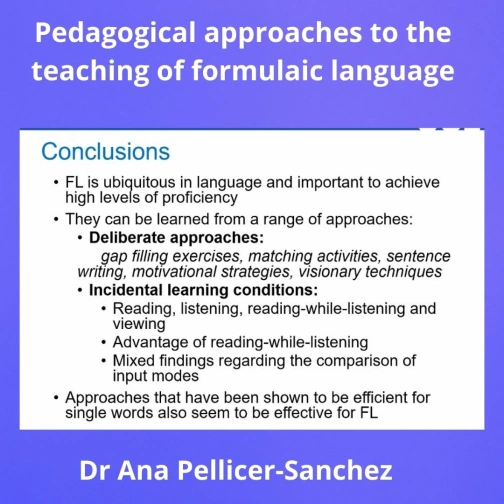A look at Pedagogical Approaches to the Teaching of Formulaic Language (FL)
Recently, I attended a great webinar, organised by the IATEFL Research SIG. The presenter was Dr Ana Pellicer-Sanchez and the topic was: Pedagogical approaches to the teaching of formulaic language (FL).
In this post I’ll provide a short summary as well as share an activity I use in my online classes. Following that, I’ll recommend a useful book with ideas for teaching lexically.
The importance of knowing vocabulary
Dr. Sanchez started by saying that learners need to acquire a large vocabulary size for successful communication, the minimum being 6000 word families. She added that form and meaning (basic knowledge of a word) usually get the most attention, at the expense of use. For example, vocabulary learning isn’t only about definition, spelling and pronunciation but also about understanding in what patterns the word occurs, what words it collocates with, in what situations we would expect to encounter it, etc.
What is formulaic language (FL)?
It’s an umbrella term for multi-word language phenomena, which holistically represent one meaning or function and are used and stored as single items/words. Other definitions you might be familiar with are language chunks, or lexical phrases. Here are some examples:
|
Collocations |
Crystal clear |
|
Idioms |
A piece of cake |
|
Binomials |
Toss and turn |
|
Trinomials |
Cool, calm and collected |
|
|
|
Is FL important?
According to research, a considerable amount of language is formulaic. Accordingly, FL should be an integral part of language pedagogy because it is crucial for achieving high levels of proficiency in a second language.
How do we teach FL?
Dr. Sanchez mentioned these two main approaches to the teaching of Formulaic Language:
- Deliberate or explicit type of learning, using activities like:
- gapfill and cloze tasks
- studying and using formulaic language in sentences
- memorizing lists
- matching exercises
- incidental learning from reading, listening, viewing, and communicative activities.
Is the teaching of Formulaic Language more difficult than single words?
In a recent study that Dr. Sanchez conducted with her PhD students during which they compared the learning of single words with that of phrasal verbs (receptively and productively), they found basically no significant differences between learning single words and phrasal verbs.
Helping students notice FL
Dr. Sanchez said that simply raising awareness by telling students to notice and pay attention to FL can be beneficial according to some studies. While I agree that when designing vocabulary activities, we also need to include language chunks, as students’ tendency is to focus on single words. For this reason, I often also use metalanguage, such as collocations, idioms or lexical chunks to facilitate noticing.
The visionary method
One of the techniques Dr. Sanchez mentioned, was asking her students to imagine their future selves being fluent, having interactions in different situations, using the target language that they were learning. This sounds like a very useful metacognitive task at the end of the lesson, to get students reflecting on how to use new language.
To sum up:
- We shouldn’t only be concerned about the number of words students learn, but also how well they know them.
- Teaching FL can help students become more fluent and proficient.
- Generally, approaches that are effective for acquisition of single words can be used with FL as well.
- It’s important to help students notice FL.
An idea for you
Here’s a Jamboard matching activity you might find useful if you’re teaching online. As you can see, I’ve selected some useful lexical chunks from the lesson, such as verb+preposition or adjective+noun collocations and fixed phrases. Subsequently, I divided them into two parts: green and yellow. Students have to match one yellow with one green sticky note to make phrases. You can see an example: without expecting anything in return. Sometimes, more than one match is possible, so stronger students can also be encouraged to think of more combinations.

Finally:
I found Teaching Lexically to be a fantastic book with lots of practical activities for teaching all skills lexically and helping learners notice and learn language in chunks. I highly recommend it!
References
Dellar, H. and Walkley, A. (2017). Teaching lexically. Stuttgart: DELTA publishing.



No Comments Yet